If folks are still second guessing the Dum’ Dum Doctrine, just take a quick look at Operation Iraqi Freedom. Yes, the U.S.-Iraq war is a fine example of doctrine-in-motion. In March, 2003 we go to war with a country that we claim—but cannot prove—poses a threat to our national security. But then, once we’re in there, oops…. we realize that there was no threat! No weapons of mass destruction. No auto-piloting aircrafts. No mustard gas. No botchulinum. No anthrax. No nuclear arsenals. No plans of taking over the world, or even the Middle East. No direct connection between Saddam and Mr. Loony-bin. And absolutely no connection whatsoever between Saddam and the events of 9/11. Nothing. Zippo. Zilch. But hey, does it really matter? Aren’t all those Iraqis happy that we’re bringing democracy to their land? Aren’t they happy that we’ve ousted that brutal evil dictator and have now installed peace, order, and liberty loving ways? Isn’t the world happy that we’ve captured that fallen dictator [24]?
Freedom is on the march, says Dum’ Dum’s balloon. And it will keep marching…. marching forward like a technocratic machine computing and creating United States’ opportunities. We must stay the course, spread democracy, and envision a world agreeable to U.S. interests. That’s why on May 1, 2003 Dum’ Dum, standing aboard the USS Abraham Lincoln, announced an end to all major combat: Mission Accomplished! The whole world got to see Dum’ Dum glide onto that air craft carrier, strut across that grand steel ship, and say to the world: Yes, we bombed, invaded, and dethroned a sovereign country without providing any substantial proof of threat whatsoever. And what are you going to do about it? Nothing! Ahhh, that Dum’ Dum, he really knows how to rock and sock the international arena.
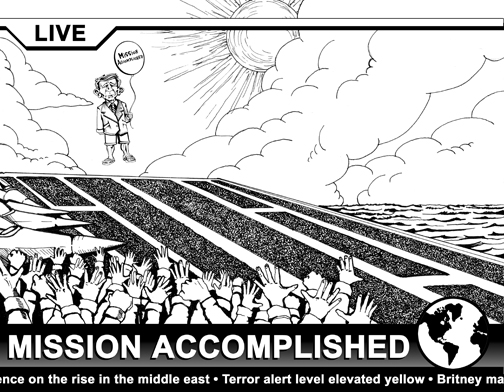
Dum’ Dum’s sound policy decision making has brought about some interesting results. Take a look here [25]:
 • Our invasion of Iraq has killed at least 25,000 Iraqi civilians, between 40-50,000 Iraqi resistance fighters, and wounded over 100,000 Iraqi civilians.
• Our invasion of Iraq has killed at least 25,000 Iraqi civilians, between 40-50,000 Iraqi resistance fighters, and wounded over 100,000 Iraqi civilians.
• Over 2,200 U.S. military personnel have died in Iraq as of January, 2006. Another 15,000 have been wounded.
• Over $200 billion have been spent on the Iraq war effort, with the cost rising every moment. That amount of money could pay the health insurance of forty-six million people, or the salary of three million elementary school teachers, or the college scholarships of thirty-nine million students. Yeah, that money was definitely well spent.
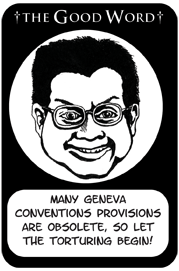 • Vice President Cheney’s former company, Halliburton, has received over $10 billion in no-bid contracts. In other words, the happy-go-lucky Dum’ Dum just gave the contract to Halliburton, no questions asked, no reasons given. Now that’s compassionate conservativism at its best.
• Vice President Cheney’s former company, Halliburton, has received over $10 billion in no-bid contracts. In other words, the happy-go-lucky Dum’ Dum just gave the contract to Halliburton, no questions asked, no reasons given. Now that’s compassionate conservativism at its best.
• U.S gasoline prices have skyrocketed, peaking at over $3 a gallon in September, 2005. These rises cannot be attributed solely to the war, but they do reveal a logic of the Dum’ Dum Doctrine: spend, exert, waste, and deal with the cleanup later.
• Iraqi resistance fighters, as well as individual terrorist cells, have used kidnappings and beheadings of non-military personnel as gruesome methods of war. These incidents have become part of our international media milieu, crafting a dual sense of personal-and-global horror akin to apocalyptic science fiction. Is this really happening?
• Iraqi resistance fighters have been abused and tortured by U.S military personnel. Such inhumane activity is another example of duplicitous discourse: benevolent, democratic, and freedom loving people who sanction torture.
• 255 civilian contractors have died in Iraq since May 1, 2003. Out of that number, 91 of them have been American.
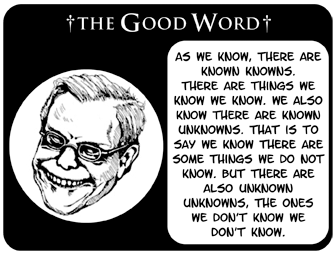 • 60 international media workers had been killed in Iraq as of August, 2005.
• 60 international media workers had been killed in Iraq as of August, 2005.
• According to the U.S. State Department, the number of “significant” international terrorist attacks tripled from 2003 to 2004—from 175 to 655.
• Madrid and London, due in part to their support of U.S. actions, have been sites of terrorist bombings, killing approximately 240 people and wounding over 2,000.
• Anti-American demonstrations have occurred in Pakistan, Indonesia, Palestine, and even Afghanistan, a country we supposedly liberated. They’re probably still jealous of our freedom.
This is not quite the saving grace people were promised. But before passing judgment, we should realize that the National Security Strategy foreshadowed much of this situation. As the Strategy states:
The war against terrorists of global reach is a global enterprise of uncertain duration . . . . America will act against such emerging threats before they are fully formed . . . . While the United States will constantly strive to enlist the support of the international community, we will not hesitate to act alone, if necessary, to exercise our right to self-defense by acting preemptively . . . . The major institutions of American national security were designed in a different era to meet different requirements. All of them must be transformed. It is time to reaffirm the essential role of American military strength. We must build our defenses beyond challenge. . . . As we defend the peace, we will also take advantage of an historic opportunity to preserve the peace. . . . [America will] strongly resist aggression from other great powers—even as we welcome their peaceful pursuit of prosperity, trade, and cultural advancement [26].
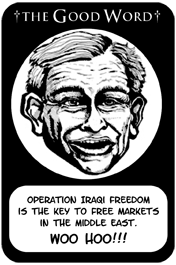 Basically, let us do what we want, have a few wars if necessary, and in about ten or fifteen years, Iraq and/or other countries will supply us with loads of cheap labor, international cargo stops, global transportation centers, tons of oil, sites for WTO meetings, strategic military bases, and governments amendable to our will power. This is an absolutely marvelous example of social engineering by preeminent figures of social power. Dum’ Dum’s Administration has set the stage for a new American era of world dominance, carrying forth the call from post-World War II reconstruction right up to the present day. That’s not easy to do. Sure, the Administration had lots of help from the unexpected events of 9/11. But they did their due diligence, jumped on the ball, and got things moving in a favorable direction—well, favorable for their own specific agenda, but favorable nonetheless.
Basically, let us do what we want, have a few wars if necessary, and in about ten or fifteen years, Iraq and/or other countries will supply us with loads of cheap labor, international cargo stops, global transportation centers, tons of oil, sites for WTO meetings, strategic military bases, and governments amendable to our will power. This is an absolutely marvelous example of social engineering by preeminent figures of social power. Dum’ Dum’s Administration has set the stage for a new American era of world dominance, carrying forth the call from post-World War II reconstruction right up to the present day. That’s not easy to do. Sure, the Administration had lots of help from the unexpected events of 9/11. But they did their due diligence, jumped on the ball, and got things moving in a favorable direction—well, favorable for their own specific agenda, but favorable nonetheless. But contrary to popular belief, the Dum’ Dum Administration is not solely responsible for our unique positioning in the twenty-first century world. We good citizens receive, respond to, interpret, and act upon Dum’ Dum’s words, strategies, actions, and applications. We are not passive consumers of Dum’ Dum’s brilliance. Instead, our consumption is a production. The way we see and hear Dum’ Dum partially creates Dum’ Dum. We turn his stuttering riddles and awkward pauses into discursive actions and socio-political realities, playing an active role in the creation and maintenance of our current situation. Most folks reject such a postulation: It’s all Dum’ Dum’s fault. He’s the head honcho. He’s a super-duper caricature running the show. His brilliance and power beholds us all! Etc. Such fatalistic perspectives insufficiently account for human freedom and ingenuity. Sure, Dum’ Dum has powers that most of us do not. But that power is relational, resting upon the active participation of others. Changing the nature of our participation changes our relationship to Dum’ Dum’s power.
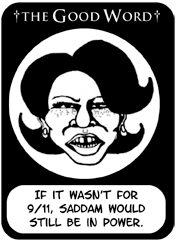 Power can be defined as the ability to control your own environment and the environment of others. Some people are obviously more powerful than other people. But absolute power does not exist. No one holds complete control over oneself or others. This lack of total control creates and is created by a tension between freedom and constraint. We are free to choose, think, act, and live, but always within limits. This tension constitutes and is constituted by a space—a space that allows for the possibility of alternative actions and thoughts. Dum’ Dum knows this and uses it to his advantage. Hence, we get the Terror Wiggle and the Texas Two-Step—i.e., the ability to create heroes and villains, disseminate duplicitous discourses, install social numbness, create non-existent justifications for war, etc. Dum’ Dum has got himself some power, and he uses it. And of course he’ll use it—he is the president, after all.
Power can be defined as the ability to control your own environment and the environment of others. Some people are obviously more powerful than other people. But absolute power does not exist. No one holds complete control over oneself or others. This lack of total control creates and is created by a tension between freedom and constraint. We are free to choose, think, act, and live, but always within limits. This tension constitutes and is constituted by a space—a space that allows for the possibility of alternative actions and thoughts. Dum’ Dum knows this and uses it to his advantage. Hence, we get the Terror Wiggle and the Texas Two-Step—i.e., the ability to create heroes and villains, disseminate duplicitous discourses, install social numbness, create non-existent justifications for war, etc. Dum’ Dum has got himself some power, and he uses it. And of course he’ll use it—he is the president, after all.But we, the little people of this country, got us some power, too. We’re not living under a monarch, and even if we were, we would still have the room to shift power relations. We are agents of discursive realities. If this is true, then we have the ability to re-route and perhaps invent new discursive realities—for example, creating a tale about a four-foot, black-and-white caricature who just happens to be president of the world’s lone super power.
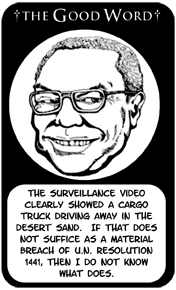 Taking up this type of “discursive activism” involves at least three things. First, we must see Dum’ Dum and his Doctrine as constructions and fabrications. Our president—every president—is a well-thought out, communicatively constructed persona. A born-again evangelical everyday C.E.O. cowboy with a tough love approach is no coincidence. Instead, it’s a discursive creation disseminated through various communication outlets. Also, pre-emptive military strikes and U.S. expansionism are neither inherent nor necessary. America’s world dominance is not driven forward by some teleological necessity. Instead, America’s current status results from various contingent histories, and Dum’ Dum’s Doctrine is a strategic response to these contingencies. That response, intentionally or not, privileges specific interests, populations, networks, ideologies, and agendas. Recognizing these constructions hopefully piques our own interests, encouraging us to think, create, and disseminate alternative dance steps to the Texas two-step.
Taking up this type of “discursive activism” involves at least three things. First, we must see Dum’ Dum and his Doctrine as constructions and fabrications. Our president—every president—is a well-thought out, communicatively constructed persona. A born-again evangelical everyday C.E.O. cowboy with a tough love approach is no coincidence. Instead, it’s a discursive creation disseminated through various communication outlets. Also, pre-emptive military strikes and U.S. expansionism are neither inherent nor necessary. America’s world dominance is not driven forward by some teleological necessity. Instead, America’s current status results from various contingent histories, and Dum’ Dum’s Doctrine is a strategic response to these contingencies. That response, intentionally or not, privileges specific interests, populations, networks, ideologies, and agendas. Recognizing these constructions hopefully piques our own interests, encouraging us to think, create, and disseminate alternative dance steps to the Texas two-step. Second, we need to more readily exploit our own wiggle rooms. That really means one thing: Think. Yes, that old and outdated technology can actually be useful in modern society. Our species has found ways to understand the earth’s gravity and rotation, communicate through outer space satellites, and construct theories of quantum physics. If this is true, then it’s not out of the realm of possibility that we can create some better ways to deal with 9/11, international politics, and the foibles of Dum’ Dum. This involves analyzing the connections among events, speeches, doctrines, and histories, and, from there, developing tactical thought that deploys new modes of thinking. That’s not to say we should look for grand conspiracies. Shakers and backers and cataclysmic events most likely act and occur independently of each other. Stuff happens, period. But there are meaningful connections in the juxtaposition of events, social actors, etc. Teasing out and re-interpreting those connections gives us material for the possibility for discursive usurpation.
 Third, and last, more folks need to get actively involved. Yes, yes, that’s what everyone says. But it’s true. If by any chance we are displeased with the current political situation, then we can’t put it off on other folks. We must take it upon ourselves to make the changes that we want to see. Waiting for our shining knight in armor is, first, a myth, and second, a reason why we’re in this situation. Dum’ Dum was elevated to super-hero status after 9/11 because most people wanted to believe that someone would save us. Oh, Dum’ Dum, you’re our hero! Save us from the evil terrorists! Yes, we support you! Well, such a desire gave us the Dum’ Dum Doctrine. So much for the “shining knight” strategy. Socio-political discursive action needs to be informed by knowledge and, to use an antiquated term, wisdom. For instance, voting for a political candidate we know nothing about doesn’t do too much good. Neither does waiting for another savior from another political party. True democracy does not rest upon a vote or the relegation of our agency to others. Instead, true democracy is a way of being in the world, resting upon (1) our search for accurate information, (2) honest and open deliberation and debate, and (3) our active and conscious political involvement. Losing sight of this perspective creates the dangerous possibility of allowing some asinine, intellectually defunct caricature to give speeches, write doctrines, represent citizens, and launch wars. Now that’s a scary thought! As Dum’ Dum said, “a dictatorship would be a heck of a lot easier, there's no question about it” [27].Yeah, it would be easier; but is that what we really want?
Third, and last, more folks need to get actively involved. Yes, yes, that’s what everyone says. But it’s true. If by any chance we are displeased with the current political situation, then we can’t put it off on other folks. We must take it upon ourselves to make the changes that we want to see. Waiting for our shining knight in armor is, first, a myth, and second, a reason why we’re in this situation. Dum’ Dum was elevated to super-hero status after 9/11 because most people wanted to believe that someone would save us. Oh, Dum’ Dum, you’re our hero! Save us from the evil terrorists! Yes, we support you! Well, such a desire gave us the Dum’ Dum Doctrine. So much for the “shining knight” strategy. Socio-political discursive action needs to be informed by knowledge and, to use an antiquated term, wisdom. For instance, voting for a political candidate we know nothing about doesn’t do too much good. Neither does waiting for another savior from another political party. True democracy does not rest upon a vote or the relegation of our agency to others. Instead, true democracy is a way of being in the world, resting upon (1) our search for accurate information, (2) honest and open deliberation and debate, and (3) our active and conscious political involvement. Losing sight of this perspective creates the dangerous possibility of allowing some asinine, intellectually defunct caricature to give speeches, write doctrines, represent citizens, and launch wars. Now that’s a scary thought! As Dum’ Dum said, “a dictatorship would be a heck of a lot easier, there's no question about it” [27].Yeah, it would be easier; but is that what we really want?
« previous | notes »

